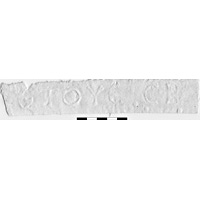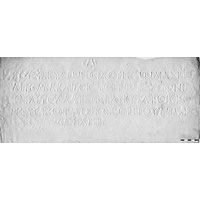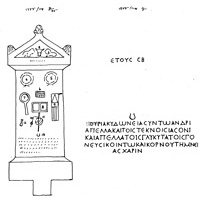 MAMA XI 98 (Kadoi)
MAMA XI 98 (Kadoi) 
Funerary stele of Quintus and Cornuta
- Type of monument:
- Funerary stele.
- Location:
- Uşak (Kadoi): in a street.
- Description:
- White marble stele, with pediment above and tenon below; complete, cracked across the middle. In the pediment: (1) lion facing r., (2) ox-head, (3) lion facing l. In the field: (4-5) two wreaths, (6) comb, (7) mirror, (8) writing-tablet, (9) stylus-case, (10) spindle, (11) distaff, (12) tear-bottle, (13) crescent. First line of inscription on pediment; lines 2-6 in field.
- Dimensions:
- Ht. 2.05; W. 0.67 (pediment), 0.56-0.58 (shaft), 0.75 (base); Th. 0.18; letters 0.016-0.023.
- Record:
- Line drawing; MB notebook copy; squeeze (1955/114).
- Publication:
- Mouseion 3 (1880) 171, no. 348; Noack 1894: 327-9, from a copy by K. Buresch (Buresch 1898: 48); [Pfuhl and Möbius 1977-9: II 551, no. 2288; MAMA X 181 P8]
- Date:
- AD 117/8 (Year 202 of Sullan era).
vac. ἔτους σβ΄ vac.
[Φ]ουρία Κυδωνεία σὺν τῷ ἀνδρὶ
Ἀπελλᾷ καὶ τοῖς τέκνοις Ἰάσονι
καὶ Ἀπελλᾷ τοῖς γλυκυτάτοις γο-
5νεῦσι Κοίντῳ καὶ Κορνούτῃ μνεί-
ας χάριν
Year 202. Furia Kydoneia, with her husband Apellas and her children Iason and Apellas, for her sweetest parents, Quintus and Cornuta, in memoriam.






In 1880, when this inscription was first seen and copied, it was located at Karabacaklar, ‘6 hours from Gediz’. It was subsequently brought to Gediz by the local kaimakam, who passed it on to a Greek landowner, who moved it to his farm Tekessian Çiftlik (between Güre and Yenişehir, on the main road from Uşak to Kula), where it was copied by Karl Buresch in 1894 (Buresch 1898: 48). In 1955, Ballance copied the inscription at Uşak, recording in his field notebook that the inscription was ‘said to have been brought from Hamitli köy’. The inscription is now (2011) located in the Uşak Museum (not, as stated by MAMA X 181, P8*, at Izmir).
The remarkable decoration on the stele finds close parallels in other funerary stelai from the region south of Kadoi (Lochman 1991: 13 [fig. 4], 19 [figs. 9 and 10]. Pace Pfuhl and Möbius 1977-9: II 551, the inscription is probably to be dated according to the Sullan era (Leschhorn 1993: 250-4).